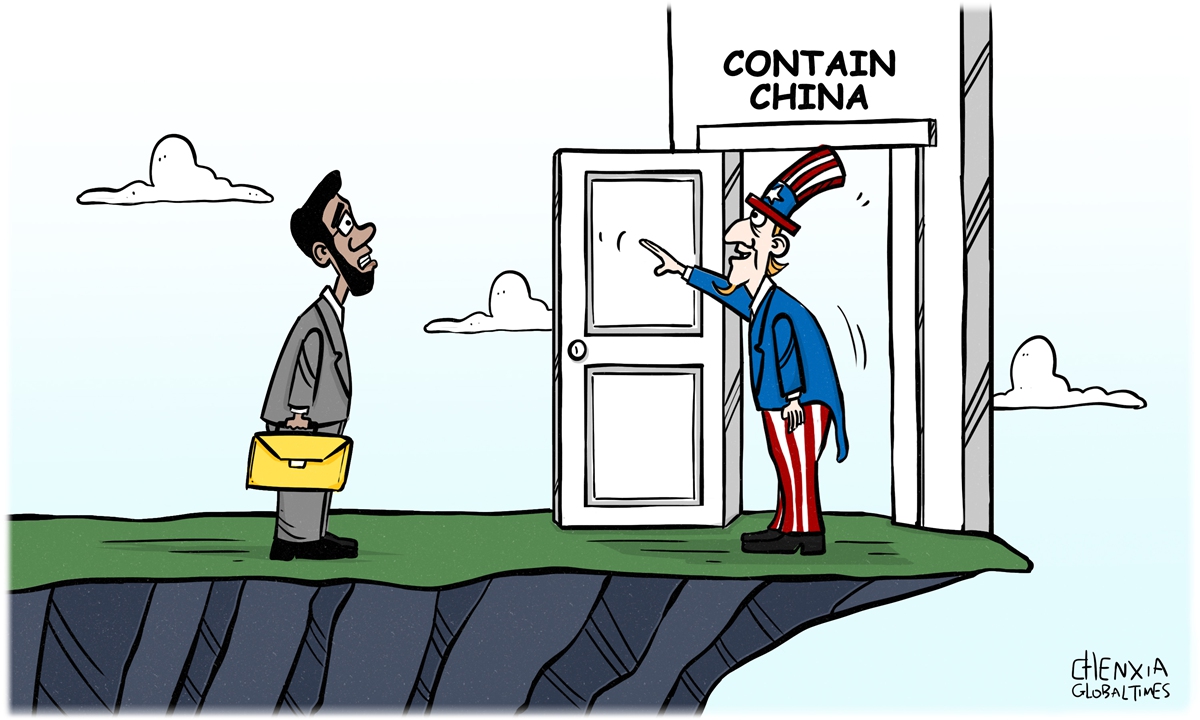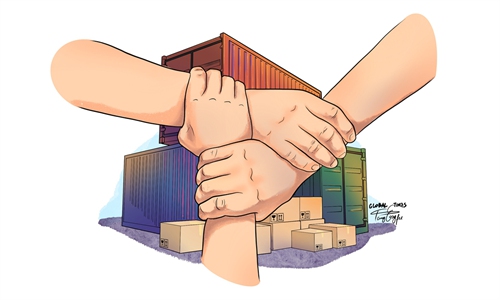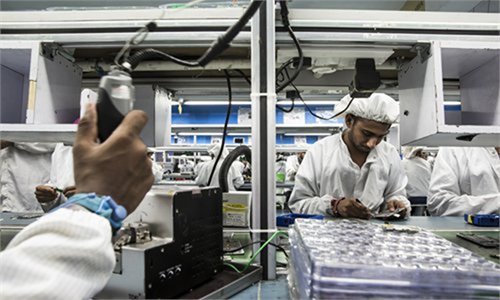
Illustration: Chen Xia/Global Times
The India-US Trade Policy Forum (TPF), a premier platform to resolve trade and investment issues between the two sides, will hold a meeting in Washington on Wednesday, the Economic Times reported. Coming at a time when Washington signals a desire for closer ties with New Delhi as tension with China builds, the upcoming forum has drawn attention to the discussion about how US-India trade relations will proceed in the future.Two-way trade between the US and India is on an upward spiral. The dominant Western narrative is that a "decoupling" of US and Chinese economy and the disruptions brought by the pandemic has heightened the importance of diversification for global businesses, and India can become the "next factory" of the world as multinational corporations relocate portions of their global supply chain to countries like India. However, this deviates from reality.
Indeed, India's foreign trade with the US has seen an increase, but this is not the whole story. There are three important aspects. First, China is rapidly moving up the manufacturing value chain, producing more sophisticated goods, and creating a higher-paid workforce in the process. It helps to boost the overall market competitiveness of Chinese high-tech corporations with an increased export to the US markets.
Second, the cost of production in China, especially in the major coastal cities, is on the rise, so some low-end manufacturers are moving portions of their production to other countries like India. Bloomberg said in September that India, believed by many to have the potential to become the next China, is finally making headway in the exports market as it has become one of the top five suppliers of Christmas decorative items and T-shirts to the US. Bilateral trade is indeed on an upward spiral, but low-cost manufacturing segments remain the highlight.
Third, although multinational corporations relocate some of their supply chain to India, manufacturing companies will not entirely move out of China. It will take time to build a complete and comprehensive industrial chain in India, and before the nation achieves that milestone, it has to import a range of intermediate products from China. An increase in demand of intermediate products in India is an inevitable result of the production shift.
There is an interesting phenomenon happening: China's exports to the US, India's exports to the US, and China's exports to India all increase at the same time. And when the three are combined together it tells the whole story.
India's overall exports to the US in the first eight months of 2022-2023 fiscal year - April to November 2022 - had reached $499.67 billion, up 17.7 percent year-on-year. China's exports to the US in the first 11 months of 2022 reached $536 billion, up 3.4 percent year-on-year. Meanwhile, a closer industrial chain is being formed between China and India. Most of the goods India imports from China are intermediate goods and raw materials that are used for meeting the demand of fast-expanding sectors like electronics, which is of great significance for India's exports and manufacturing. China's exports to India stood at $108.7 billion from January to November 2022, up 23.9 percent year-on-year.
We should observe the US-India economic relations and trade frictions under this background. The US is one of the few economies with which India has a trade surplus. Currently, growth in US trade deficit with India has become a hidden danger to the bilateral ties. India is likely to face mounting pressure from Washington to reduce its trade surplus with the US.
As a result, there have been increasing trade disputes between the US and India in recent years due to rising trade protectionism. While the two countries will hold a trade forum this week, one trade dispute remains unresolved. India in 2018 had approached the World Trade Organisation (WTO) against the US move to impose 25 percent and 10 percent import duties on certain steel and aluminum products on security grounds. India may take up the matter on the sidelines of the upcoming forum in Washington this week, Indian media outlet Business Standard reported on Thursday, citing a person aware of the matter.
With India' s growing economic clout, Washington has signaled a desire for closer ties with New Delhi. The US may need India to contain China, further intensifying its so-call decoupling push, but US politicians may be deeply disappointed by the result. This line of logic is simple: US-India bilateral trade friction is increasing with trade volume growth.
As bilateral ties between India and the US grow increasingly complicated, India should enhance its own economic strength, which will be a key bargaining chip at the negotiating table. To further strengthen industrial cooperation with China will benefit India's growing exports and economy. As it will take time for India to build a complete and comprehensive industrial chain, the country's fast-expanding manufacturing needs intermediate products from China, the only country recognized by the UN as having a complete industrial system, to support its exports growth before it achieves that milestone.
The author is a reporter with the Global Times. bizopinion@globaltimes.com.cn



